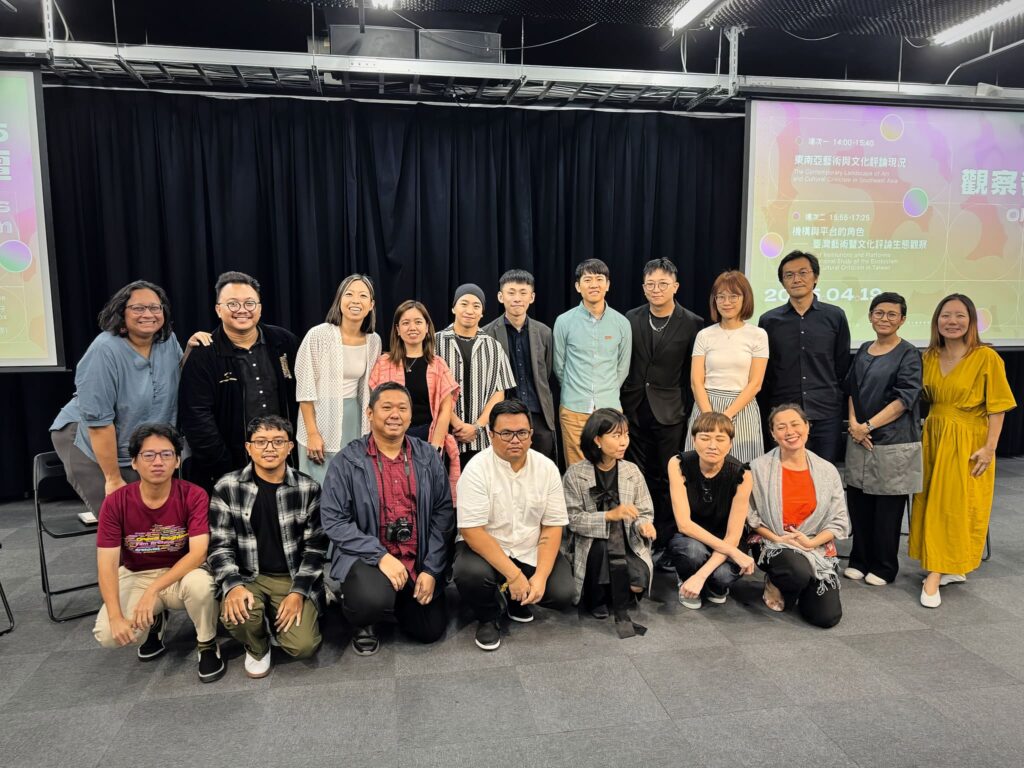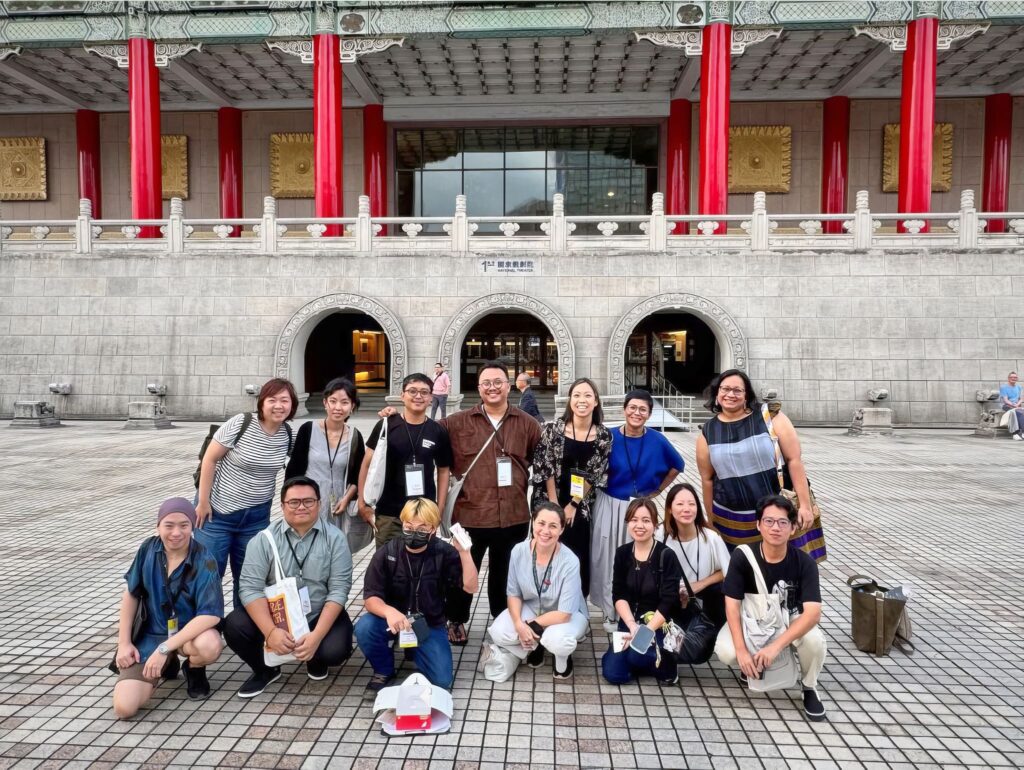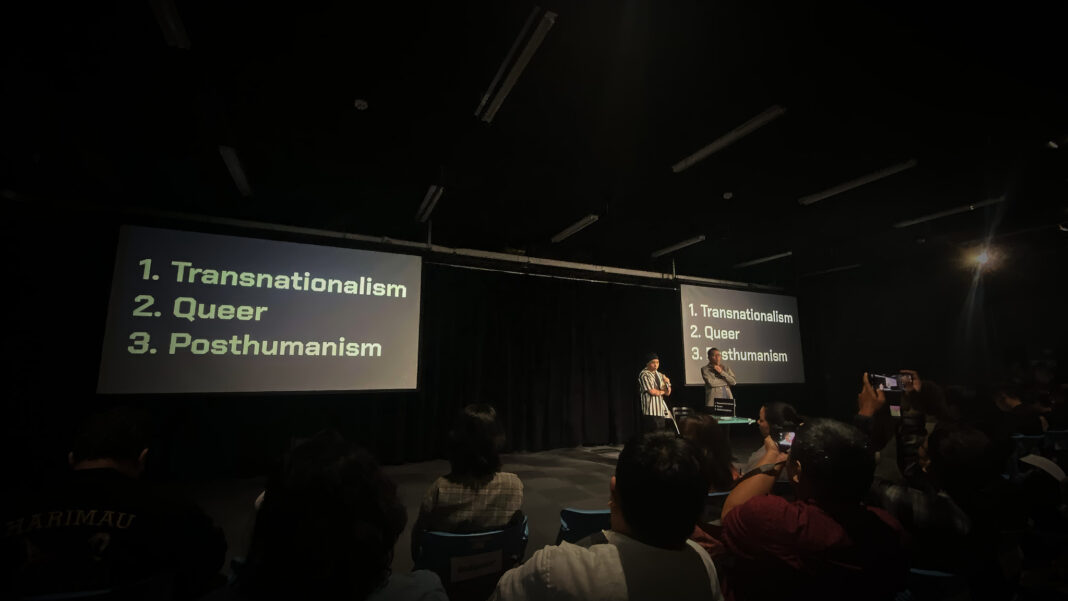My arrival in Taipei for the ArtsEquator Fellowship’s Critics Network in mid-April 2025 was an immersion into a nexus of creative energy. The 2025 Observers Forum, hosted at the dynamic Taiwan Contemporary Culture Lab (C-LAB), Taiwan’s Ministry of Culture, and the Taipei Economic and Cultural Office in Malaysia, buzzed with an intellectual vibrancy that was both welcoming and keenly focused. Six of us received an opportunity to share about the art criticism in Southeast Asia and the perspective we took as a platform for a deep dive into our fellowship projects, along with Taiwanese panelists. I presented my research, “Mek◊ng Sci-Fi: Toward Fut◊rity,” to an engaged audience of arts professionals from Southeast Asia and Taiwan, and subsequently being invited to expand on this at the National Taipei University of Education’s (NTUE) esteemed international Critical and Curatorial Studies of Contemporary Art program, was more than a professional engagement. It became an unexpected lens. The receptiveness to dialogues about new narratives and alternative futures felt like a microcosm of Taiwan’s own extraordinary story—a nation built on relentless becoming, profound resilience, and an unwavering gaze toward what’s next. This experience during my #taiwanweek2025 compelled me to look deeper into the currents driving this island’s remarkable journey.

From Fields to Foundries: The Architecture of Resilience
Taiwan orchestrated a stunning metamorphosis over the past half-century. From a primarily agrarian society, it systematically engineered its ascent to an industrial, and then a globally pivotal, high-tech powerhouse. This transformation was no accident; it resulted from audacious strategic foresight, sustained investment in human capital through education and research, and an ingrained national ethos of unyielding perseverance. The meticulous organization of the whole trip and the evident academic rigor I encountered at NTUE seemed a direct inheritance of this disciplined, strategic approach that underpins Taiwan’s national development—a quiet, formidable “never give up” spirit that has consistently turned challenge into opportunity.
The Semiconductor Crown: Forging Global Indispensability
Nowhere is this strategic mastery more evident than in Taiwan’s commanding position in the global semiconductor industry. Spearheaded by giants like Taiwan Semiconductor Manufacturing Company (TSMC), the nation has cemented its indispensable role in the foundational technology that powers our digital world. This leadership transcends mere industrial might; it constitutes a critical geopolitical asset, often termed the “Silicon Shield,” providing Taiwan with significant leverage. Attaining this preeminence demanded not just technological brilliance but decades of focused investment, bold risk-taking, and an unwavering commitment to excellence. This pursuit of cutting-edge mastery, I realized, provided a crucial context for the innovative spirit I witnessed across Taiwan—a culture where using intellect to critically and progressively push boundaries, whether in chip design or in crafting new cultural narratives, is not just encouraged but intrinsically valued.
Taiwan’s influence extends far beyond its technological prowess; it actively cultivates a potent soft power, not through imposition, but using attraction, shared values, and a vibrant cultural tapestry, forming a framework in diplomacy. This sophistication was vividly apparent throughout my visit.
Soft Power in Action: A Symphony of Culture and Innovation
The nation’s performing arts serve as powerful cultural ambassadors. During #taiwanweek2025, I experienced Cloud Gate Dance Theatre’s “Sounding Light,” a contemporary masterpiece. As I noted then, this work by the first contemporary dance company in the Sinophone world, now under the artistic direction of CHENG Tsung-lung, saw dancers become “living architecture,” masterfully translating local sensibilities into sublime, universal art. It was a compelling assertion of a distinct Taiwanese cultural identity on the world stage, significantly supported by Taiwan’s major national performing arts centers.
This cultural depth is multifaceted. I also encountered the Bulareyaung Dance Company’s “tiaen tiamen Episode 2.” This new form of “techno-Butoh,” offering a potent “techno-spiritual Indigenous experience,” as I described it in my reflections, powerfully wove Paiwan heritage with vibrant visual technologies and explicitly queer elements. Staged with significant institutional backing at Taipei’s National Theater, it showcased a nation unafraid to place contemporary Indigenous and LGBTQ+ expressions at its cultural forefront, demonstrating a dynamic fusion of tradition and audacious modernity.
This commitment to innovation finds fertile ground in new media, particularly virtual reality, where Taiwan dares to explore territories others might shun.
My #taiwanweek2025 analysis of Chou Tung-Yen’s VR film “In the Mist” highlighted this audacious spirit. The Venice Film Festival-featured piece, significantly backed by Taiwanese governmental bodies including the Industrial Development Bureau and Kaohsiung Bureau of Cultural Affairs, masterfully harnesses VR for profoundly intimate storytelling. It immerses the viewer in the place you have never been—or some of you did—a hazy, hyper-intimate environment of a gay sauna, featuring a dozen full-frontal nude male figures, with erections—a level of explicitness and artistic exploration unthinkable with state support in many places, and a clear demarcation of being “Taiwan,” a path of expressive freedom that is not possible in “China.”
The film’s unique power to evoke raw empathy was starkly illustrated by an anecdote from its creation: one of the actors, when later viewing the finished VR experience, initially observed a figure sitting alone amidst the passionate orgy around him. His first thought was, “He’s so pathetic; no one wants him.” Only moments later, with a jolting wave of recognition and subsequent profound loneliness, did he realize that solitary, judged figure was himself, captured on set during the filming. This tearful self-recognition underscores VR’s capacity to dismantle initial judgments and force a confrontation with shared human vulnerability and insecurity, particularly within LGBTQ+ experiences. “In the Mist” thus exemplifies not only Taiwan’s embrace of technological advancement for artistic ends but also its courageous investment in boundary-pushing, proudly queer narratives that foster deep, often uncomfortable, introspection and connection—a potent form of cultural expression distinct on the global stage.
Navigating Complex Currents: Resilience, Reckoning, and Democratic Identity
Taiwan navigates a uniquely challenging geopolitical landscape. Its technological supremacy, vibrant democracy, and compelling soft power are not merely assets but crucial instruments for maintaining international relationships, building alliances, and asserting its distinct identity. This resilience is further fortified by a courageous willingness to confront its own complex past.
During #taiwanweek2025, this became strikingly clear through Singing Chen’s Venice Film Festival award-winning VR film “The Man Who Couldn’t Leave.” Commissioned by the Jing Mei National Human Rights Museum, the film offers an immersive, harrowing journey into Taiwan’s White Terror period. As I reflected then, this internationally acclaimed work serves as a vital act of remembrance, by employing innovative VR to explore historical trauma with such unflinching intimacy, echoing the sensibilities of the nation’s pride, Taiwan New Cinema.
Taiwan not only fosters understanding but also powerfully underscores its commitment to truth, human rights, and democratic values—pillars that reinforce its distinct and respected international standing.
Toward Fut◊rity: An Enduring Spirit of Exchange
Taiwan’s unwavering commitment to innovation—in technology, cultural expression, and democratic practice—is palpable. The vibrant cultural landscape I witnessed, from the introspective VR experiences like “In the Mist” and “The Man Who Couldn’t Leave” to the expressive power of Cloud Gate and Bulareyaung Dance Company, all curated and supported with clear national vision, deeply resonated with my explorations of “Mek◊ng Sci-Fi.” It revealed a shared, urgent interest across Asia and, indeed, across the Global South, in forging new narratives and envisioning alternative futures. Taiwan is not passively awaiting its future; it is actively architecting it.
My encounters in Taipei offered more than intellectual stimulation; they provided a profound insight into a nation that thrives on resilience, embraces innovation with rigor, and champions cultural exchange as a cornerstone of its identity. Taiwan’s journey, marked by its transformation from paddy fields to a technological and cultural driver, offers a compelling narrative of hope and a testament to the power of a forward-looking spirit. The international dialogues fostered there are vital. Taiwan’s continued journey serves as a potent inspiration for navigating our complex global future with ingenuity and an unwavering belief in human potential.

The opinion expressed is solely that of the author. Subscribe to the Fut◊rity Newsletter to show support and follow the development of my thoughts.
The ArtsEquator Fellowship Critics Network is made possible with the support of Taiwan’s Ministry of Culture and the Taipei Economic and Cultural Office in Malaysia.
